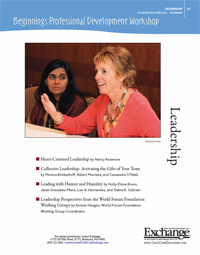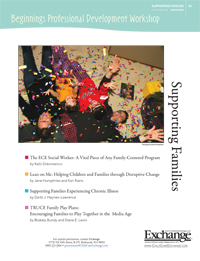ExchangeEveryDay Past Issues
 << Previous Issue
| View Past Issues | | Next Issue >>
<< Previous Issue
| View Past Issues | | Next Issue >> -Turkish Proverb
- Lights glare overhead. The neon bulbs are shining continuously, now in many states, even at naptime.
- Bright colors are everywhere. The bright, primary colors are on the walls, furniture, equipment, décor, and sometimes even on the floor.
- Noise is constant. There are sounds of children playing, yelling, crying, and laughing — and the noise of adults’ conversations, children's toys, and perhaps music playing...
- Space is confining. The classroom overflows with tables, chairs, cubbies, shelving units, bookcases, large muscle equipment, and a plethora of supplies, toys, and materials...
- Smells are overpowering. In the air, there might be a mix of strong odors typical of early childhood classrooms.
"...Being in Times Square is an experience that many people enjoy for a couple of hours every few years. When it gets to be too much, they duck into a store, catch a show, stop for some refreshments, or head back to their hotels. For young children, leaving the classroom is not an option. For many, children live in environments like Times Square eight to ten hours a day, five days a week. And their response to these chaotic environments is often increased challenging behavior and decreased engagement and learning.
"As early childhood professionals, we must strive to create spaces that caress, as opposed to assault young children’s senses. Spaces that are conducive to learning and prosocial behaviors are those that are high in sensory engagement rather than sensory overload. Sensory engagement comes from the natural incorporation of interesting items for children to explore through their senses."
$4 Each For 24 Hours Only!
Enter Code "beginnings4" when prompted.
Exchange Press has 120 16-page Beginnings Workshop units, each addressing a specific early childhood curriculum topic in-depth. For two days only, all Beginnings Workshop units are on sale for $4 each!
View and Purchase Titles
(Offer applies to PDF only. Sale ends 05/04/2016 11:59 pm PDT)
ExchangeEveryDay
Delivered five days a week containing news, success stories, solutions, trend reports, and much more.
What is ExchangeEveryDay?
ExchangeEveryDay is the official electronic newsletter for Exchange Press. It is delivered five days a week containing news stories, success stories, solutions, trend reports, and much more.
Only $6.00 per order and 50% profit on every sale. Your bank account will start Greening up!






Comments (3)
Displaying All 3 CommentsOMEP-USA
Washington, DC, United States
I agree with the two previous comments and want to add that one big reason for the TimesSquare experience is that many learning centers are not housed in buildings designed for that purpose. They are in buildings intended for commercial or infrequent usages such as store fronts or religious institutions. Thus, when a center opens in a non-child-friendly environment, we must figure out ways to modify the environment and make it comfortable, reasonably quiet and, from time to time, subdued. This, then, leads us early educators to understand interior design and to work with architects and interior designers so that they know what to do for children. Positive actions on behalf of young children encompass all that we know about space, equipment and teaching, including inside and outside environments.
United States
How refreshing it is to hear someone else voice the same opinion I have had for years. When I was a classroom teacher, my goal was to engage children's minds in learning, exploring and discovering while in a tranquil setting. It proved to be a constant battle with the established core that wanted all of the classrooms to have that cookie cutter image. I was known as the renegade but to me the children were worth the fight.
United States
You have just described the environment of many, many five-star child care centers! And why are they like this? In some cases, perhaps, it is because of the standards to which they feel they must adhere - so many of this toy, so much of that activity, so much of this or that sensory stimulation. What happened to the understanding that what active, relationship-based, nature-rich natural childhood provides creates a foundation for intelligence and engagement for children. It is a sad and pathetic description you have presented, but until we understand that the systems that early childhood educators are buying into (or perhaps only tolerating) are a major part of the problem, we will continue to see such environments. It is time for us to ramp up our advocacy on behalf of children and tell the "standards" folks to go home and create the environements they are forcing upon children in their own homes. Let's see how long it takes before they are needing psychiatric care!
Post a Comment